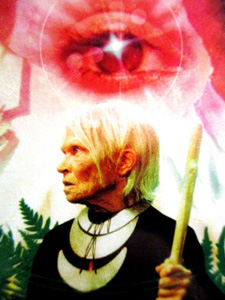Kinda
“That ends as it has always done, in chaos and despair. It ends as it begins, in the darkness.” – Panna
Were the effects and design of this story up to the level of the script and direction, this would easily be among the best Doctor Who stories of all. As it is, it is still one of the best for the Davison era and for sure my favorite of that time. Granted, I perhaps have a bit of skewed view having read the story many times over as a child before ever seeing it on screen; I was thus not impeded by the less-than-perfect visuals for which the story is notorious (nor by the oddity of the ‘native’ casting) and was instead introduced solely to the gem of a story it is. Even then, some aspects of the broadcast—Tegan’s dreaming sequence, the strength of the portrayal of Panna, are definitely something special to see.
The story starts off a bit stilted as we meet characters that seem way too overacted—the blustering old school captain and pedantic underling—but it soon becomes clear that this is intentional to highlight how “broken” they are from the beginning. The utter normalcy of Todd stands in stark contrast to them and shows that it’s not the intention of the story to be a farce. Events in the dome really start to move along from Hindle’s breakdown onward. It’s almost uncomfortable to see him lose it, smashing plants and glasses left and right, only to suddenly compose himself and wipe a wisp of hair to the side in an obvious sign of insanity. As he descends into childlike madness, we feel as on edge as the others in the dome having to walk on eggshells around him. It’s this tension, fear of what this man-child might actually do, that really keeps the story going. Obvious forced happiness that belies fear underneath is always scary.
Peter Davison’s Doctor starts to solidify his personality here—utterly cheerful and affable in the face of the fiercest pushback, always trying to hide his frustrations with the unreasonable people around him. I love the moments where he gives up and drops this pretense with a wearied sigh. Adric continues to be rather whiny but it’s fun to see Tegan get to react to it. Her role in the dream sequence is huge and quite well done. It’s just too bad the only way to make the story work was to use a rather contrived excuse to remove both Nyssa and the sonic screwdriver from the story.
The Kinda half of the story might not have worked as well if the character of Panna hadn’t been portrayed so excellently. She commands respect and exudes strength and somehow we just know there is something very deep to her every decision. No one else gets to constantly refer to the Doctor as a fool! This is complemented very well by the increasingly confident character of her pupil Karuna and the sudden handover in the middle is amazing. It’s also surprising how much pathos the Trickster character brings. When we see the happy little man suddenly saddened by his beloved marotte baton destroyed or writhing in pain in the vision, it truly does seem like the world is ending.
Over all, there’s just a lot of fun and mysterious sci-fi in this—the primitive natives wearing double helixes, the “We” and “Not-We”, the simple yet complex society of telepaths where women with “voice” rule. I find it particularly interesting how they have the natives construct a branch and leaves copy of the armored machine. Intentional or not, this echoes the legacy of cargo cults and the devastation of colonial contact they heralded. The whole story is also quite enriched by borrowings from Buddhist philosophy. The urgency of Panna to have Todd and the Doctor see and understand the turning of the great wheel is gripping. (“Wheel turns, civilizations arise, wheel turns, civilizations fall.”) While it has its excesses such as the cliffhanger scream at opening the box, the story really builds up tension and dread better than any stories had done for years.
Best (or worst) unsettling moment:
Special mention has to again be made of the sequence of Tegan in the dreaming. The heavy makeup and white lighting serve to make figures of the elderly couple in the otherworldly void all the more misshapen and frightening. Just as we feel off kilter and frightened along with Tegan, the final manifestation is even more ghastly with how gaunt he looks and the way his teeth stand out horribly. I don’t know if it was intended for his dialogue to be so forceful—the script is such that they could have been played coy and mysterious—but he literally spits out his lines with full contempt. It gives the reading a ton of edge and menace as he bares his teeth with each word. The confusion and worry Tegan faces is just really well done.
Retrofit:
I didn’t learn until this watch that the figures Tegan encounters in her dream are named. They are called Anicca, Anatta, and Dukkha which are themselves ancient Buddhist terms for the three marks of existence. As befits a rich story, there are fan theories about them beyond the confines of the story itself–most interestingly that they are either the trapped lost team members of the expedition or are manifestations of Tegan’s subconscious images of Adric, Nyssa, and the Doctor.
Regrets:
Most people just remember the fake snake at the end. What a shame to miss a great story just for that. Ignoring the effects, there are only just a few touches of acting I would have liked to have seen be more realistic. (Aris lacks the menace that the dream world Mara had). Also, I am not sure if it might have come off too colonial, but I always imagined the Kinda played by people of more Aboriginal ancestry.

